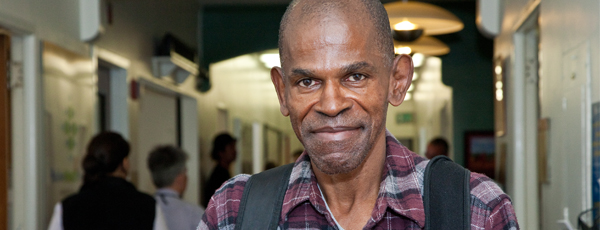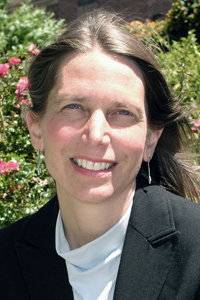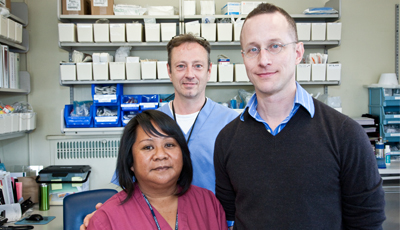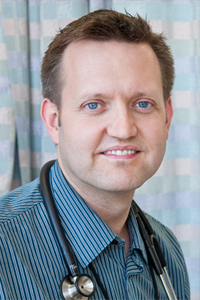SFGH's Ward 86: Pioneering HIV/AIDS Care for 30 Years

Reginald Jones, who is HIV-positive, is among the patients being served at San Francisco General Hospital's Ward 86, a primary care clinic that is a collaborative effort between the San Francisco Department of Public Health and UCSF.
Ward 86 at San Francisco General Hospital (SFGH) and Trauma Center was the first HIV/AIDS-specialized clinic to open its doors to patients, and quickly became an international leader in care and research.
SFGH HIV/AIDS Patient Facts
- 3,000 patients
- 30,000 patient visits per year
- 14 percent women
- 35 percent Hepatitis C+
- 79 percent on antiretroviral therapy
During the early days of the AIDS epidemic a diagnosis of the once mysterious illness was an almost certain death sentence. The partnership between SFGH and UCSF, which began in 1873, has played an integral part in understanding the virus and developing treatments that can make it possible for patients to manage this deadly disease and live long and fruitful lives.
“Back in the 1980s, HIV patients had a life expectancy of about 18 months,” said Brad Hare, MD, medical director of Ward 86, part of the Positive Health Program. “Now, we tell them to plan for retirement.”
Today, Ward 86 patients range from 18 to 82, with the average age of 47 years old.
Through its goal of putting patients first, clinicians at Ward 86 helped develop the San Francisco model of compassionate care as the worldwide standard. Founded in 1983 by pioneering UCSF physicians Paul Volberding, MD, Donald Abrams, MD, and Constance Wofsy, MD, it immediately became the center of care and treatment for the San Francisco AIDS epidemic.

Diane Havlir, MD
Diane Havlir, MD, now chief of the UCSF Division of HIV/AIDS at SFGH, and Diane Jones, RN, both worked in the world’s first inpatient AIDS ward at SFGH. Over time, a standard of care evolved in the inpatient and outpatient clinics that addressed the whole needs of patient wellbeing: medical, social, psychological and often economic. Among the many firsts were non-traditional definitions of family and next of kin, social support groups and transitional housing programs.
This model of care has helped maintain dignity in the lives of people suffering from a misunderstood disease and experiencing rejection and discrimination. It was also found to be the most effective way to help patients adhere to treatment regimens – and ultimately to save lives. The current clinical team includes doctors, nurse practitioners, both RN and LVN nurses, pharmacists, social workers and psychiatrists. They rely on a customized clinical database programmed under the direction of fellow physician James Kahn, MD, also a UCSF professor in the Division of HIV/AIDS.
“In the early days, what we had to offer was compassion in the face of stigma,” Havlir said. “With the San Francisco model, we developed a holistic approach that treats the whole patient, from their HIV to addiction, mental illness, housing or whatever challenges they are facing. That model is now the world standard and it continues to evolve today, for instance, meeting the needs of older patients.”
As the nation recognizes 30 years of HIV/AIDS, Ward 86 continues to be a leader in the fight against the disease. A new generation of doctors and clinicians are carrying forward the fight and expanding it around the globe. They have taken their model of care internationally with the AIDS Services, Prevention, Intervention, Research and Education (ASPIRE) program training clinicians in Africa, and addressing barriers to testing and patient care due to the stigma of AIDS and prevalence of poverty throughout the continent.
Leading the Charge of Universal Testing
Ward 86 also is leading the charge on universal testing and treatment initiatives, addressing the reality that one in four HIV-positive individuals are believed to be unaware of their status. SFGH has made universal HIV testing available to all patients and initiated bridging programs to ensure newly diagnosed individuals overcome barriers and receive immediate care.

From left, Cyril Sola, LVN, John Wesner, medical assistant intern, and Terrence Marcotte, NP, are part of the team in Ward 86 at San Francisco General Hospital.
The push for universal testing at SFGH was made after Havlir and her team formally recommended universal treatment for all HIV positive patients last year. Advancements in HIV drugs have made those drugs easier for patients to tolerate and shutting down HIV replication as early as possible may reduce patients’ organ damage from the virus.
“At San Francisco General Hospital, we offer treatment to everyone as soon as we know their HIV status,” Havlir said. “Because the virus starts damaging the organs even before the infection sets in, that’s a tremendous benefit to the patient. A secondary benefit is that early treatment has been shown to reduce transmission rates as well.”
30 Years of AIDS
- 30 Years of AIDS homepage
- Learning Lessons from an HIV Cure
- SFGH Grand Rounds Explores Disease That First Defined AIDS
- UCSF Marks Three Decades of AIDS
- SFGH's Ward 86: Pioneering HIV/AIDS Care for 30 Years
- Treatment is Key to Prevention of HIV/AIDS, Doctors Say
- AIDS Virus May Accelerate Aging, Scientists Say
- First AIDS Research Conference in Uganda Focuses on Building Collaborations
- Thirty Years of AIDS: A Timeline of the Epidemic
- UCSF and AIDS: Facts and Firsts
- Share your story on Facebook
But the stigma and fear surrounding the disease remain an obstacle for many. And many communities are disproportionally impacted by HIV and AIDS.
“People react to the diagnosis the same way they did 30 years ago,” said Jones, who works with new HIV patients. “They think that they’re going to die, that they can’t tell anyone, and, if they are women, that they can’t have kids. None of these things has to be true anymore.”
HIV/AIDS has changed from a disease traditionally identified with younger gay men to one that impacts all ages, genders, sexual orientation, races and ethnicities. Currently, Ward 86 treats about 3,000 patients including gay and straight men, women, African-Americans, Latinos, transgender individuals and an increasing number of Asians and Pacific Islanders.

Brad Hare, MD
“The face of HIV was gay men, but today it wears different faces,” said Royce Lin, MD, a physician at Ward 86. Lin, who was 9 when the epidemic first hit, treats many Asian and Pacific Islander patients – minority groups that have among the highest rates of new infections. “Asian women are least likely to be offered HIV tests by ob/gyns,” he said, due to the stereotype of Asian women as a “model minority” without much risk of being infected.
Despite everything now known and understood about HIV/AIDS, 500 to 700 new infections still occur each year in San Francisco alone. Having access to a dedicated clinic that provides them with world-class primary, holistic care – along with specialized HIV care – makes all the difference for Ward 86 patients.
“We still have a challenge on our hands, but now we have the tools to reduce it,” Havlir said. “Our patients are wonderful. It is thanks to them that we have been able to match research to treatment and make giant leaps forward in the last 30 years. Today, we believe that a cure is within our reach.”
Photos (except for Diane Havlir) by Susan Merrell